Until this week, my Dial Guide only had 5 Type A dials. Now there are six!
Before we discuss dial A6, let me first give some background on Seamaster text order and how it sparked my interest in studying cal. 1040 watches in the first place.
Dial Classification – How It Started
I purchased my first 1040 back in 2015 after performing what I thought was significant research. I had made a checklist of expected traits to look for: satin blue dial, white subdial at 6, white bezel, applied hour indexes, white hands with signs of tritium aging that matched the lume on the dial, orange “jet” chrono minutes hand. I thought I was being thorough, and snagged a watch in good condition for a good price that met all the criteria.
It was maybe a month later when I noticed that the text order on my dial was OMEGA Seamaster AUTOMATIC (OSA), and most 176.007s had the following text order: OMEGA AUTOMATIC Seamaster (OAS). I had a mild panic attack thinking I bought a redial, but the quality was too good. My next theory was that maybe the OSA text was correct for 176.001 and I had an authentic dial, but just incorrect for 176.007. I spent a lot of time doing Google image searches and eventually realized OSA text order was seen more commonly in 176.001s, but was also common enough in 176.007s. Crisis averted, obsession just beginning.
This was the point back in early 2016 when I started making detailed notes that would eventually become this website. I started noticing more dial features I was initially blind to and began documenting each dial variant in detail, by each feature. As it turns out, most dials that were meant for the 176.001 and 176.007 Seamasters – the ones I’d eventually classify as Types A, B, and C – came in both OAS and OSA text order. There was one exception, or so I thought. I could never find a silver dial with OSA text.
I considered the silver OSA Seamaster a “missing link” – a dial that theoretically “should” exist based on the patterns of other known dials. I even mentioned this missing dial in a February post about another dial that I had expected to find but originally didn’t, the brown Yachting dial I4.
Right Under My Nose
This week I finally discovered the silver OSA dial during a Google Image search that pointed me to this old thread on Watchuseek while doing research for a new collector’s guide to casebacks (coming soon, I promise). Actually I shouldn’t say “discovered”. I should say “noticed what had been in front of my face for a while” because the thread shows two movement serial numbers that I had already documented in my research, citing that same thread as the source. I have no idea how I had missed that since I had been looking at dials for longer than I had been collecting serial numbers.
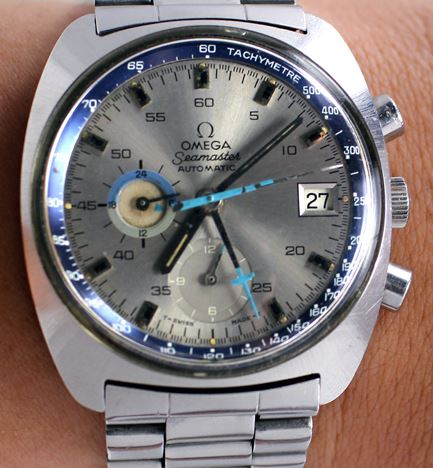
These photos do give me pause though – the printing appears thicker than normal which leaves open the possibility that this was simply an A3 dial that was incorrectly repainted. The poor condition of the hands and 24 hour disc however make me lean towards the dial being original – in other words I believe that if anyone was attempting to repaint the dial they would have repaired or repainted the other visible parts too.
Had I discovered it prior to coming up with my typology, it probably would have been called A4, but I don’t want to rename an existing dial, so this silver OSA becomes A6. There’s nothing remarkable about the dial other than the fact that it went undetected by me for so long. It’s the last of the “theoretical” dials out there, so I don’t expect to be discovering any new dials anytime soon.
Check out the updated dial guide here, or go directly to the page for A dials. Have a watch with this dial? Send along some photos if you get a chance.
Main Image Source: Watchuseek, posted by ditoy_eagle


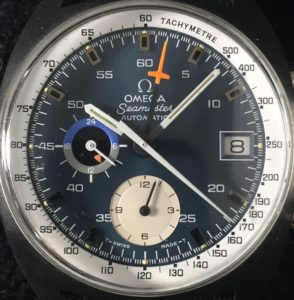
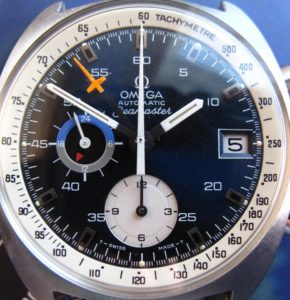
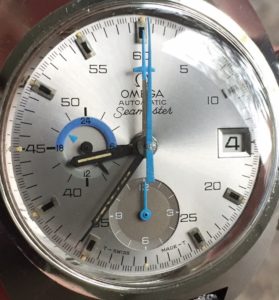
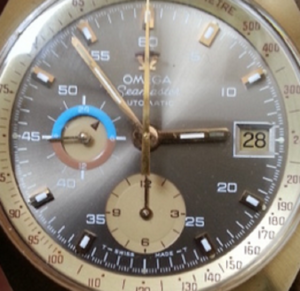
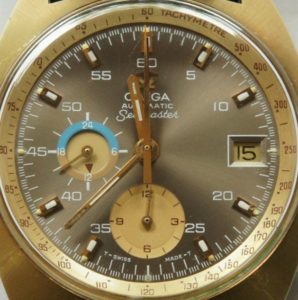
I have an OAS that is almost exact to the A6 dial except the blue tachymetre ring is a lighter blue. Any thoughts?
Hi Alex, can you email me some photos? Hard to judge without, although there are some noticable variations on the color of those bezels so it is probably fine. More on bezels here: http://www.calibre1040.com/collectors-guide-bezels/